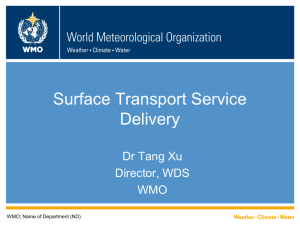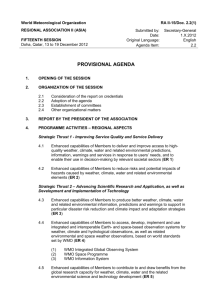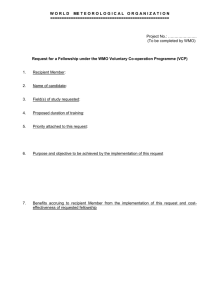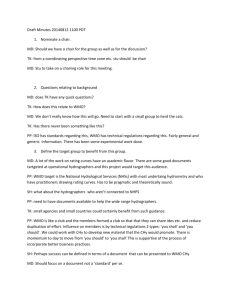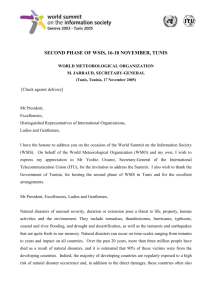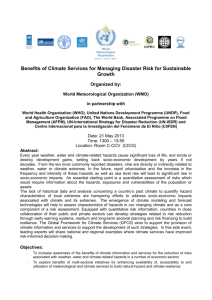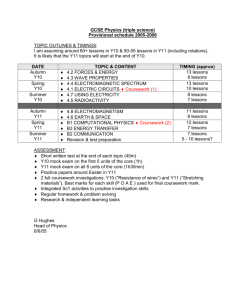Monitoring and Evaluation
advertisement
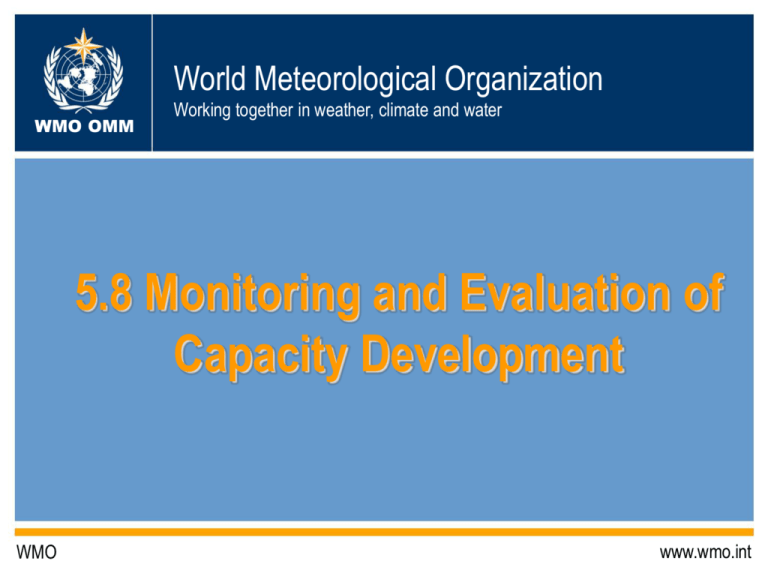
World Meteorological Organization WMO OMM Working together in weather, climate and water 5.8 Monitoring and Evaluation of Capacity Development WMO www.wmo.int Linkage between the next SP, OP and RBB SP WMO OMM OP (2012-15) KOn11 Del GSN STn ERn1 KOn12 Del Del KOn13 SECRETARIAT RBB (2012-15) Act Budget Act Budget Act Budget Act Budget Framework of the Results-based WMO Operating Plan and Secretariat Budget 2012-2015 WMO OMM (5) ST 1 (8) ER 1 KOs of RA I … VI Indicators, Baselines, Targets Secretariat Departments Activities and Budget KOs of TC1 … TC8 Indicators, Baselines Targets ER 1 ER 2 ER 2 Strategic level For every ER, each RA and TC will define specific Key Outcomes together with Indicators, Baselines and Targets; based on these plans and in close coordination the Secretariat develops deliverables, activities and budget proposals. Operational level KO’s , KPI’s and Priority Areas WMO OMM • • • ST2: Advancing scientific research and application as well as development and implementation of technology ER4:Enhanced capabilities of Members to access, develop, implement and use integrated and interoperable surface-based and space-based systems for weather, climate and hydrological observations, as well as related environmental observations, based on world standards set by WMO. KO 4.1: WMO Integrated Global Observing System (WIGOS) is implemented • KPI – Completion of WIGOS milestones according to WIGOS implementation plan., – Increased availability of observations for users • Priority: WIGOS and WIS are priority areas • • Total of 24KOs, most of them have not more than 2KPIs. Additional 7 KOs on GFCS and DRR as major initiatives WMO OMM Strategic planning documents 1. WMO Strategic Plan : High-level statement of strategic directions and priorities expressed through Strategic Thrusts and organization-wide Expected Results and Performance Indicators addressing the Global Societal Needs; 2. WMO Operating Plan: converts the organization-wide ERs into specific outcomes/ deliverables, indicators and targets 3. Secretariat Implementation Plan and budget: converts the organization-wide ERs into Secretariat specific outcomes/ deliverables, indicators and targets and links them to the planned activities and the Secretariat budget; 4. WMO Strategic Executive summary: In a language appealing to those outside WMO and those making decisions to fund NMHSs. and Tool/System for Monitoring & Performance Evaluation – Tracks implementation and provides for control and corrective actions for achieving the ERs. WMO OMM WMO Strategy for Capacity Development : Why? • Establish a CD Strategy to ensure, in a holistic approach, all actors in Met/Hydro/Climate work towards the same overall objective : Facilitating sustainable development of NMHS Resolution Cg-XVI/B/WP 11.2 • Congress noted that a coordinated and cohesive approach for capacity development would be needed to enhance capabilities of NMHSs in developing countries to meet growing Societal Needs at different levels. • Congress noted that capacity building is a crosscutting activity and contributes to all Expected Results (ER), especially ER 6 and Strategic Thrust 3 of the 2012-2015 Strategic Plan. WMO OMM Definitions and Logic of WMO strategic planning approach GSNs : Global Societal Needs STs : Strategic Thrusts WMO Strategic Plan ERs : Expected Results KOs : Key Outcomes Actions and Budget WMO OP 20122015 WMO OMM WMO OMM Strategic Thrust n3 Expected Result n6 WMO OMM Tools to Monitor and Evaluate Progress • Types: Empirical, Qualitative, Index, breadbasket, case histories, Indicators (available economic, social or environmental) • Example Collection tools: – – – – – Self reporting: Surveys, Visits of PR and national staff Country assessments National Records Reports: OPAGS, Regional WGs, Fellowship Evaluations, project evaluation Country Profile Data Base WMO OMM Conceptual Framework for Monitoring and Evaluation Feedback and learning M&E M&E M&E M&E Inputs Activities Deliverables Expected Results Key Outcomes WMO governance decisions Activities as stipulated in the WMO Operating Plan based on contributions of the TCs, RA and the Secretariat Deliverables as stipulated in the WMO Operating Plan based on contributions of the TCs, RAs and the Secretariat Expected Results as stipulated in the WMO Strategic Plan Key Outcomes as stipulated in the WMO Operating Plan TCs and RAs human resources Financial & human resources: WMO Secretariat WMO Joint Programmes Members Partner Organizations’ contributions Activities of WMO Joint Programmes Activities of Members Deliverables of WMO Joint Programmes Deliverables of Members WMO Secretariat enabling processes and coordination Expected Results of WMO Joint Programmes Key Outcomes of WMO Joint Programmes WMO OMM Capacity Development – and ER 6 Expected Result 6: Enhanced capabilities of NMHSs, in particular in developing and least developed countries, to fulfil their mandates. Looking at Key Outcomes (Kos) and Key Performance Indicators (KPIs) How do we measure? WMO OMM EC-WG/SOP Questionnaire • The working group reviewed in 2011 a standardized questionnaire to assess the impacts of the achieved results. • Such a survey could help create baselines and targets. WMO OMM Draft Survey on WMO Impacts of Achieved Results on Members Survey Questions for Capacity Development, ER 6 Key Outcomes 6.1-6.4 KO 6.1: NMHSs and Regional Centers are improved, particularly in developing and least developed countries WMO OMM KPI 6.1.1: Number of NMHSs and WMO Regional Centers with defined roles in national and regional socioeconomic development activities, in cooperation with international and regional development agencies 1. Has your NMHS been involved in national or regional socio-economic development activities in cooperation with international and regional development agencies? Yes 2. Does your NMHS have a defined role in the National Development Plan? Yes 3. No No If yes, please define your key role: WMO OMM KPI 6.1.2: Number of NMHSs with programmes and networks for collaborating on service delivery at regional levels 4. During the past two years, has your NMHS carried out programmes or become part of a network for collaborating on service delivery at regional level? Yes No 5. Does your NMHS carry out programmes or participate in networks on service delivery at Regional level? Yes No 6. If yes, please give details: WMO OMM • KO 6.2: Infrastructure and operational facilities of NMHSs and Regional Centres are improved, particularly in developing and least developed countries WMO OMM KPI 6.2.1: Number of NMHSs with improvement in infrastructure and operational facilities to address identified deficiencies 7. During the last two years has your NMHS implemented or developed improvements to its service delivery capacity? Yes No 8. If yes, i. In the surface observing network? Yes No ii. In the upper-air observing network? Yes No iii. In equipment for meteorological/environmental satellite data? Yes No iv. In the data-processing/forecasting sector? v. In other operational sectors of your NMHS (please specify) Yes No KPI 6.2.2: Number of NMHSs with modernized capacities to develop and disseminate products to their customers WMO OMM 9. What distribution systems do you use to get products and services to users? i. Telephone of facsimile ii. Media (printed, TV & Radio) iii. SMS iv. Cell Broadcast v. Internet (web pages, ftp, email etc.) vi. Social networking (twitter, face book etc) vii. Dedicated telecommunication links viii. Remote displays (electronic bill boards etc) ix. Staff attachment to users of centres of operation x. Remote briefing (video conference, telephone, help desk etc.) xi. Others (please list) WMO OMM • KO 6.3: Education and Training Development activities at national and regional levels are improved, especially in developing and least developed countries WMO OMM KPI 6.3.1: The number of RTCs providing education and training support for GFCS related activities • To be completed by WMO Secretariat using other sources. KPI 6.3.2: The degree to which Members are getting value for money from the WMO Fellowship Programme WMO OMM 10. Has your NMHS contributed to or had students under the WMO Fellowship Programme during the past two years? Yes 11. No If yes, In general terms, how would you rate the value your NMHS has been getting from the Fellowship Programme? 1= very low; 5= very high 1 2 3 4 5 WMO OMM KPI 6.3.3: The degree to which the RTCs support the regional training demands in particular for students from developing and least developed countries 12. If you send staff to a WMO Regional Training Centre(s), please indicate by inserting ‘X’ the WMO Region(s) where the RTC(s) are located: WMO Regions I II III IV V VI 13. From your perspective, how would you rate the degree of satisfaction with the RTC(s) you use? 1= very low; 5= very high 1 2 3 4 5 WMO OMM • KO 6.4: Capacities of NMHSs are enhanced through cooperation and partnerships with other national and regional organizations KPI 6.4.1: Development projects and activities funded through voluntary and extra-budgetary resources WMO OMM • To be completed by WMO Secretariat using other sources. WMO OMM Your inputs…ideas? • Questions in Survey…. – Are we measuring what needs to be measured to show the capacities of NMHS are being developed? – Are the questions • Too simple (yes/no) to be of use? • Too difficult to answer with enough specificity to show improvement in 4 years? • About right – What other tools does WMO need to develop/improve (if any) to evaluate and monitor CD? WMO OMM Additional Sources • Survey on the Role and Operation of Meteorological Services (2011) • Regional Surveys • Programmatic Surveys • Information from assessments done on bilateral basis, other development agencies or at subregional levels as part of project development WMO Strategic Plan 2012 – 2015 Key Performance Indicator(KPI) Reference Sheet KPI: WMO OMM Expected Result: Key Outcome: UNIT OF MEASURE PLAN FOR DATA ACQUISITION Data collection method: Annex 1 KPI reference sheet to be completed Data source(s): Timing/frequency of data acquisition: Estimated cost of data acquisition: Responsible department: Responsible individual(s): DATA QUALITY ISSUES Data limitations (if any): Actions planned to address data limitations: PLAN FOR DATA ANALYSIS, REVIEW, & REPORTING How the data will be analyzed: How data will be presented: Reporting date and to whom: WMO Strategic Plan 2012 – 2015 Key Performance Indicator (KPI) Reference Sheet 5.2.1: Increased research on operations products and services WMO OMM Expected Result 5: Enhanced capabilities of Members to contribute to and draw benefits from the global research capacity for weather, climate, water and environmental science and technology development Key Outcome 5.2: Research in the prediction of high-impact weather on time scales of hours to seasons is enhanced UNIT OF MEASURE Assessment by JSC of WWRP on progress in high-impact weather. Annex 2 Example of a duly completed KPI Reference Sheet PLAN FOR DATA ACQUISITION Data collection method: annual meetings of WWRP JSC Data source(s): reports from WWRP working/expert groups/team Timing/frequency of data acquisition: once per year Estimated cost of data acquisition: minimal Responsible department: RES/ARE/WWR Responsible Individual(s): C/WWR DATA QUALITY ISSUES Data limitations (if any): Actions planned to address data limitations: PLAN FOR DATA ANALYSIS, REVIEW, & REPORTING How the data will be analyzed: review of reports by JSC members, discussion at annual meeting How data will be presented: report from annual JSC/WWRP meeting Reporting date and to whom: June each year; to CAS and WMO leadership
